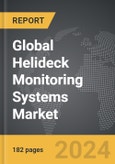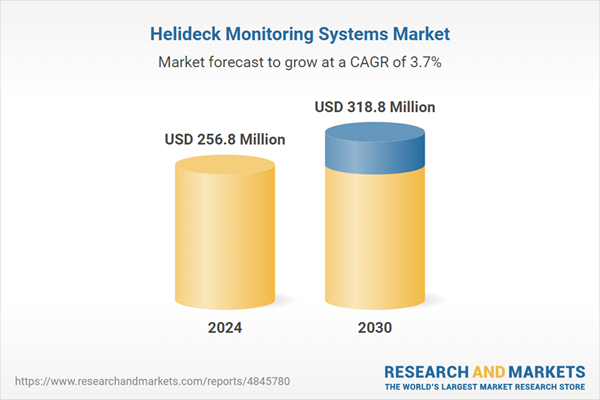Global Helideck Monitoring Systems Market - Key Trends and Drivers Summarized
Are Helideck Monitoring Systems the Future of Offshore Aviation Safety?
Helideck Monitoring Systems (HMS) are emerging as a crucial technology for ensuring the safety and efficiency of helicopter operations on offshore platforms, but what makes these systems so essential? Helideck monitoring systems are designed to provide real-time data on environmental conditions, such as wind speed, wave height, visibility, and deck motion, which are critical for safe helicopter takeoff and landing. Offshore environments, such as oil rigs, wind farms, and marine vessels, are inherently unstable due to changing weather and sea conditions, and without accurate data, helicopter operations could face significant risks. HMS not only improves safety for pilots and crew but also helps in decision-making, enabling better planning for helicopter flights in these challenging environments.The primary function of a helideck monitoring system is to track and relay precise information about the motion of the helideck, which can move unpredictably due to waves and wind. It also measures meteorological and oceanographic data to ensure that helicopters can operate within safe parameters. Pilots rely on this data to make informed decisions about landing or delaying flights. By minimizing the risks associated with offshore aviation, helideck monitoring systems play an indispensable role in keeping crew members safe, preventing accidents, and ensuring smooth helicopter operations. As offshore industries continue to grow, the need for reliable helideck monitoring systems is becoming more apparent in ensuring both operational efficiency and safety.
How Has Technology Enhanced Helideck Monitoring Systems?
Technological advancements have greatly improved the functionality, accuracy, and reliability of helideck monitoring systems, making them indispensable in modern offshore operations. One of the key innovations is the integration of advanced motion sensors, such as gyroscopes and accelerometers, which provide precise data on the movement of the helideck in real time. These sensors measure heave (vertical motion), pitch, and roll, offering pilots a complete picture of the deck's behavior under various sea and wind conditions. This real-time data allows for more accurate decision-making, reducing the risk of accidents during takeoff and landing.Another significant technological enhancement is the inclusion of highly sensitive weather monitoring equipment, including anemometers, barometers, and visibility sensors, which give detailed readings of wind speed, direction, humidity, and air pressure. This meteorological data is critical for understanding the atmospheric conditions that could impact helicopter operations, particularly in regions prone to sudden weather changes. Many modern systems also incorporate wave radars, which monitor the height and frequency of waves, providing essential information about the sea state that can affect the stability of the helideck.
Furthermore, the integration of data analytics and cloud-based platforms has revolutionized the way helideck monitoring systems operate. Real-time data from the system can be transmitted to onshore control centers, allowing for centralized monitoring and better coordination of helicopter operations across multiple offshore platforms. In addition, some advanced systems offer predictive capabilities, using historical data and environmental trends to forecast potential risks, giving operators the ability to preemptively plan around challenging conditions. These technological advancements have not only increased the precision of helideck monitoring but have also enhanced safety and operational efficiency, making offshore helicopter transport more reliable and secure.
Why Are Helideck Monitoring Systems Essential for Offshore Operations?
Helideck monitoring systems are vital for offshore operations due to the high-risk environments in which helicopters must operate. In industries like oil and gas, offshore wind energy, and maritime logistics, helicopters are a primary mode of transport for crew changes, equipment delivery, and emergency evacuations. These operations often take place in remote areas where weather conditions can change rapidly, and the helidecks themselves are subject to constant motion from waves and wind. Without accurate data from an HMS, the risks of unsafe landings, accidents, and delays increase significantly, potentially jeopardizing the safety of crew members and disrupting critical operations.The stability of offshore platforms and vessels is constantly affected by environmental forces, and even slight shifts in the deck's position can make helicopter landings dangerous. Helideck monitoring systems provide pilots with real-time motion and weather data, allowing them to assess whether it is safe to approach the deck. This data-driven approach is especially important in emergency situations, where quick, informed decisions can save lives. Moreover, HMS helps to reduce costly delays caused by unfavorable weather conditions by providing precise information that enables better scheduling and risk management.
In addition to safety, HMS contributes to the operational efficiency of offshore projects. Reliable data from helideck monitoring systems helps operators optimize flight schedules, reducing unnecessary waiting times and improving overall productivity. In sectors like offshore oil and gas, where delays can lead to significant financial losses, the ability to operate helicopters safely in a wider range of conditions is crucial. Helideck monitoring systems ensure that helicopter flights are conducted safely and efficiently, minimizing downtime and enhancing the overall reliability of offshore operations.
What Factors Are Driving the Growth of the Helideck Monitoring Systems Market?
The growth of the helideck monitoring systems market is driven by several factors, including the expansion of offshore industries, increasing safety regulations, and advancements in monitoring technology. One of the primary drivers is the rising demand for offshore oil and gas exploration and production, particularly in deep-water and harsh environments. As these industries push into more challenging offshore regions, the need for reliable helicopter transportation becomes even more critical, and helideck monitoring systems provide the data needed to ensure safe and efficient operations in these remote areas.Another significant factor is the growth of offshore wind energy, which requires regular helicopter transport for the maintenance of turbines located far from the coast. With the global push toward renewable energy, the offshore wind sector is expanding rapidly, creating a higher demand for systems that can ensure safe helicopter landings and takeoffs under unpredictable weather conditions. Helideck monitoring systems are essential in this context, as they allow operators to maintain safe flight operations and minimize disruptions caused by adverse sea and weather conditions.
Safety regulations imposed by international aviation and maritime authorities are also playing a key role in driving market growth. Regulatory bodies such as the International Civil Aviation Organization (ICAO) and the International Maritime Organization (IMO) have set strict standards for helicopter operations in offshore environments, including requirements for helideck monitoring. Compliance with these regulations is mandatory for offshore operators, and the adoption of advanced HMS technology helps companies meet these safety standards while also reducing the risk of accidents and improving operational efficiency.
Technological advancements are another important driver of market growth. Innovations in sensor technology, data analytics, and real-time communication systems have made helideck monitoring systems more accurate and easier to integrate with other offshore infrastructure. The ability to provide real-time data and predictive analytics has enhanced the decision-making process for both pilots and offshore operators, making HMS a critical tool in managing the risks associated with offshore helicopter operations. As these technologies continue to evolve, the demand for advanced, reliable helideck monitoring systems is expected to grow across various offshore industries, from energy production to maritime transport.
Report Scope
The report analyzes the Helideck Monitoring Systems market, presented in terms of market value (USD). The analysis covers the key segments and geographic regions outlined below.- Segments: System (Hardware, Software); Application (Commercial, Defense); Vertical (Oil & Gas, Marine).
- Geographic Regions/Countries: World; United States; Canada; Japan; China; Europe (France; Germany; Italy; United Kingdom; and Rest of Europe); Asia-Pacific; Rest of World.
Key Insights:
- Market Growth: Understand the significant growth trajectory of the Commercial Application segment, which is expected to reach US$185.5 Million by 2030 with a CAGR of 3.1%. The Defense Application segment is also set to grow at 4.5% CAGR over the analysis period.
- Regional Analysis: Gain insights into the U.S. market, valued at $68.3 Million in 2024, and China, forecasted to grow at an impressive 3.6% CAGR to reach $51.2 Million by 2030. Discover growth trends in other key regions, including Japan, Canada, Germany, and the Asia-Pacific.
Why You Should Buy This Report:
- Detailed Market Analysis: Access a thorough analysis of the Global Helideck Monitoring Systems Market, covering all major geographic regions and market segments.
- Competitive Insights: Get an overview of the competitive landscape, including the market presence of major players across different geographies.
- Future Trends and Drivers: Understand the key trends and drivers shaping the future of the Global Helideck Monitoring Systems Market.
- Actionable Insights: Benefit from actionable insights that can help you identify new revenue opportunities and make strategic business decisions.
Key Questions Answered:
- How is the Global Helideck Monitoring Systems Market expected to evolve by 2030?
- What are the main drivers and restraints affecting the market?
- Which market segments will grow the most over the forecast period?
- How will market shares for different regions and segments change by 2030?
- Who are the leading players in the market, and what are their prospects?
Report Features:
- Comprehensive Market Data: Independent analysis of annual sales and market forecasts in US$ Million from 2024 to 2030.
- In-Depth Regional Analysis: Detailed insights into key markets, including the U.S., China, Japan, Canada, Europe, Asia-Pacific, Latin America, Middle East, and Africa.
- Company Profiles: Coverage of players such as ABB Ltd., ASB Systems Pvt. Ltd., Automasjon & Data AS, AWA Marine, Dynamax, Inc. and more.
- Complimentary Updates: Receive free report updates for one year to keep you informed of the latest market developments.
Some of the 14 companies featured in this Helideck Monitoring Systems market report include:
- ABB Ltd.
- ASB Systems Pvt. Ltd.
- Automasjon & Data AS
- AWA Marine
- Dynamax, Inc.
- Fugro N.V.
- Kongsberg Gruppen ASA
- Miros AS
- Monitor Systems
- Observator Group
- RH Marine
- RigStat, LP
- ShoreConnection International AS
- Vaisala Oyj
This edition integrates the latest global trade and economic shifts into comprehensive market analysis. Key updates include:
- Tariff and Trade Impact: Insights into global tariff negotiations across 180+ countries, with analysis of supply chain turbulence, sourcing disruptions, and geographic realignment. Special focus on 2025 as a pivotal year for trade tensions, including updated perspectives on the Trump-era tariffs.
- Adjusted Forecasts and Analytics: Revised global and regional market forecasts through 2030, incorporating tariff effects, economic uncertainty, and structural changes in globalization. Includes historical analysis from 2015 to 2023.
- Strategic Market Dynamics: Evaluation of revised market prospects, regional outlooks, and key economic indicators such as population and urbanization trends.
- Innovation & Technology Trends: Latest developments in product and process innovation, emerging technologies, and key industry drivers shaping the competitive landscape.
- Competitive Intelligence: Updated global market share estimates for 2025, competitive positioning of major players (Strong/Active/Niche/Trivial), and refined focus on leading global brands and core players.
- Expert Insight & Commentary: Strategic analysis from economists, trade experts, and domain specialists to contextualize market shifts and identify emerging opportunities.
Table of Contents
Companies Mentioned (Partial List)
A selection of companies mentioned in this report includes, but is not limited to:
- ABB Ltd.
- ASB Systems Pvt. Ltd.
- Automasjon & Data AS
- AWA Marine
- Dynamax, Inc.
- Fugro N.V.
- Kongsberg Gruppen ASA
- Miros AS
- Monitor Systems
- Observator Group
- RH Marine
- RigStat, LP
- ShoreConnection International AS
- Vaisala Oyj
Table Information
| Report Attribute | Details |
|---|---|
| No. of Pages | 182 |
| Published | December 2025 |
| Forecast Period | 2024 - 2030 |
| Estimated Market Value ( USD | $ 256.8 Million |
| Forecasted Market Value ( USD | $ 318.8 Million |
| Compound Annual Growth Rate | 3.7% |
| Regions Covered | Global |









